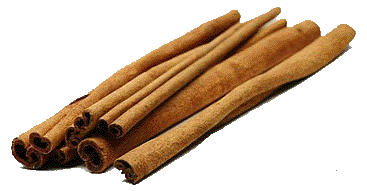SPICES - CASSIA / CINNAMON

Cassia (Cinnamomum) is an evergreen tree native to southern China and Vietnam. Like its close relative, Cinnamon (Cinnamomum zeylanicum, also known as "true cinnamon" or "Ceylon cinnamon"), it is used primarily for its aromatic bark, which is used as a spice, often under the culinary name of "cinnamon".
The buds are also used as a spice, especially in India and in Ancient Rome.The Cassia tree grows to 10-15 m tall, with greyish bark, and hard elongated leaves 10-15 cm long, that have a decidedly reddish colour when young.
CASSIA HISTORY
Native to Ceylon (Sri Lanka), true cinnamon, Cinnamomum zeylanicum, dates back in Chinese writings to 2800 B.C., and is still known as kwai in the Chinese language today. Its botanical name derives from the Hebraic and Arabic term amomon, meaning fragrant spice plant.
Ancient Egyptians used cinnamon in their embalming process. From their word for cannon, Italians called it canella, meaning "little tube," which aptly describes cinnamon sticks.In the first century A.D., Pliny the Elder wrote of 350 grams of cinnamon as being equal in value to over five kilograms of silver, about fifteen times the value of silver per weight.Medieval physicians used cinnamon in medicines to treat coughing, hoarseness and sore throats.
As a sign of remorse, Roman Emperor Nero ordered a year's supply of cinnamon be burnt after he murdered his wife.The spice was also valued for its preservative qualities for meat due to the phenols which inhibit the the bacteria responsible for spoilage, with the added bonus being the strong cinnamon aroma masked the stench of aged meats.
In the 17th century, the Dutch seized the world's largest cinnamon supplier, the island of Ceylon, from the Portuguese, demanding outrageous quotas from the poor laboring Chalia caste. When the Dutch learned of a source of cinnamon along the coast of India, they bribed and threatened the local king to destroy it all, thus preserving their monopoly on the prized spice.
In 1795, England seized Ceylon from the French, who had acquired it from their victory over Holland during the Revolutionary Wars. (In the Victorian language of flowers, cinnamon means "my fortune is yours.")However, by 1833, the downfall of the cinnamon monopoly had begun when other countries found it could be easily grown in such areas as Java, Sumatra, Borneo, Mauritius, Réunion and Guyana.
Cinnamon is now also grown in South America, the West Indies, and other tropical climates.
